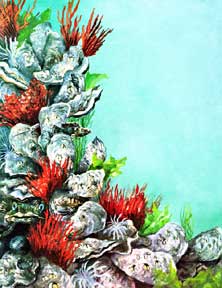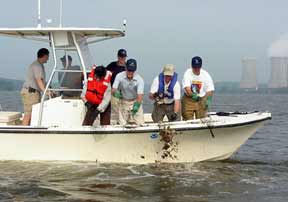|
|
 |
| Illustration by Cindy Fletcher-Holden |
Asian oysters look good and taste so much like our native oysters that even experts can’t tell them apart.
by Sandra Martin
Over the Bay Bridge at W.H. Harris Seafood in Grasonville, bushels of oysters are shucking out at a woeful 4.5 pints, well short of the six pints that Karen Oertel and her partners need to make a profit. This winter’s flaccid, watery Chesapeake Bay oysters are yet another signal of our once-great fishery’s critical condition. They’re also proof to Oertel that her industry needs new blood.
Down the Patuxent at Warren Denton Seafood, “oysters have dropped almost to nothing,” threatening the survival of the last seafood processor on the once fertile river.
The scarcity of Bay oysters — the great species Crassostrea virginica that once fed America all the way to the Pacific — is nothing new. The Bay’s oyster industry is a shadow of its historic self, having plummeted for a century before making slight gains in the late 1990s.
What is new, certainly to Chesapeake Country, is Crassostrea ariakensis. Suddenly and dramatically, this Asian oyster has swept onto the scene as the savior of Bay oystering.
Oystering has been to Chesapeake waters what tobacco has been to its farms. It’s the crop on which towns and roads were built — literally, with oyster shell as their base. It’s the crop that made work for many and fortune for a few. It’s the crop that gave our Bay its fame. That the Chesapeake oyster industry could go forward without the oyster that created it has, until now, been virtually unthinkable. It’s as if Maryland’s tobacco industry were to seek its future in marijuana.
Yet that’s just what’s astir.
Amid yet another weak harvest of oysters, the Asian oyster is stirring up interest and plans for action up and down the Bay.
“We think C. ariakensis has a tremendous lot of possibilities as far as revitalizing this industry,” says Oertel, who has traveled widely to understand oyster reseeding and served as a long-time board member for Maryland’s Oyster Recovery Partnership. “We feel we need to do some testing with it in Maryland waters to see if there are any problems.”
She is not alone.
|
|
photo courtesy of Virginia Marine Resources Commission
Native Chesapeake Oysters — Crassostrea virginica — at left above and below, compared to the Asian oyster — Crassostrea ariakensis — above and below at right. |
|
|
|
Oyster Woes
How has an obscure Asian oyster become a contender?
Need is one factor.
It’s more than a momentary pinch Oertel — and her industry — is feeling. As an owner of the 56-year-old Harris complex, she has witnessed the steady, bewildering decline of the once-famous Chesapeake Bay oyster.
Here’s what she’s seen.
Since 1945, when W.H. Harris Seafood opened its doors, Maryland’s harvest of Bay oysters has never risen above four million bushels. In 1983, the harvest dropped below two million bushels. In 1987, it fell below one million bushels. Then, in 1994, the bottom fell out: The harvest scraped an all-time low of 79,617 bushels. Since then, it fluctuates between 200,000 and 400,000 bushels.
If you back that picture up into the 19th century, it looks even worse. On a graph, our oyster’s last 120 years look like this:
In the late 19th century, when harvests reached 15 million bushels, virginica sat high atop the Rocky Mountains’ towering Pikes Peak. Into the 20th century, it fell through lower peaks to foothills, dropping to four million bushels or less by 1910. By 1988, virginica had reached the Kansas flatland of less than half a million bushels.
Desperation is another factor propelling ariakensis to the fore. Falling with the oysters is the whole industry that thrived on the legendary shellfish.
In water communities on both sides of the Bay, you might still have an oysterman as a neighbor, but you’re more likely to know a retired oysterman who’s gone into charter fishing or the building trades.
“Ten years ago, there was probably 5,000 or 6,000 oystermen,” says Larry Simns, president of the Maryland Watermen’s Association. “Today there are less than 500. And so far this year, oystering’s a third worse than it was last year, which was reasonably good. This year we lost Eastern Bay, which was a major producer last year. Over summer and into fall, 75 percent of Eastern Bay oysters died.”
 The native seafood processing plants that shucked, packaged and transported Bay oysters to the world are another endangered species. Baltimore alone canned five million bushels of oysters in 1873-4. In a 1994 paper for the Baltimore Museum of Industry called “Before It Was Crabtown, Baltimore was Oyster City,” Edmund Allen Nelson — the second-generation owner of an Eastern Shore processing plant opened in 1912 — described the 1880s as an even more prosperous oyster decade: The native seafood processing plants that shucked, packaged and transported Bay oysters to the world are another endangered species. Baltimore alone canned five million bushels of oysters in 1873-4. In a 1994 paper for the Baltimore Museum of Industry called “Before It Was Crabtown, Baltimore was Oyster City,” Edmund Allen Nelson — the second-generation owner of an Eastern Shore processing plant opened in 1912 — described the 1880s as an even more prosperous oyster decade:
The city itself consumed more than 800,000 bushels per season. The cries of oyster peddlers echoed down the streets. Dozens of raw oyster bars flourished where now only two or three can be found. Oyster canning factories were full of the hubbub of immigrant dialects. Over 3,000 black shuckers were opening Baltimore oysters.
From dozens, Maryland is down to less than a half-dozen major seafood processors. The likely closing of Warren Denton Seafood leaves only one shell-to-can processor on the Western Shore: Thompson’s Seafood at Coltons Point in St. Mary’s County.
“This is not rocket science,” says Oyster Recovery Partnership director Charlie Frentz. “It’s supply and demand. Availability keeps these businesses going.”
Scarce as oysters have been, help is scarcer. Even if there were oysters, would there be anybody willing to shuck them? Traditionally, shucking has been a craft of African Americans and immigrants. Nowadays, shuckers are a dying breed. Processing plants like Harris and Warren Denton have filled the gap with Mexican workers who travel north on short-term work visas. The native shucker is becoming a folk artist, like a blacksmith, on display at seafood festivals.
A New Oyster for a New Century?
Ariakensis, its supporters say, could do for Chesapeake Bay what its cousin, gigas, did for the West Coast. It could resurrect our moribund oyster industry and more. It could help restore our Bay.
We know as much as we do about ariakensis because up and down its part of the Bay, Virginia has tested the Asian oysters alongside our native oyster. In every case, the Asian oyster has won.
Virginia piled on the fuel to heat up the debate because its need is greater. In Virginia, where waters are saltier as the Bay nears the ocean, Maryland’s plight is redoubled. Harvests there are below 60,000 bushels — which is lower than Maryland’s worst year. Just as oysters once thrived in Virginia’s brinier waters, so too does the deadly oyster parasite Dermo.
“Virginia is in a severe tailspin,” says Jim Wesson, who oversees oyster restoration for the Virginia Marine Resources Commission, the equivalent of the fisheries branch of Maryland’s Department of Natural Resources.
“As well as we’re doing with our Bay restoration activities, all our oysters still die. Diseases are the driving force controlling our oyster populations, and 2001 — our third year of severe drought — is worse than ever before. Our industry is dying for lack of product.”
Virginia’s official interest in “possible oyster candidates” to take over where the native oyster had failed began in 1995, at the direction of the General Assembly.
From lab tests, Virginia’s caged and neutered Asian oysters moved next into free-flowing waters. Over the last two years, these oysters were tested at six sites with salinity ranging from low to high.
What the researchers say they have found thus far is stunning success: a fast-growing oyster immune to the dreaded blight of MSX and able to withstand Dermo — diseases that have no effect on humans but that lay waste to the oyster bars vital for both the Bay’s economy and its health.
In nine months, Wesson says, “every one of the ariakensis had reached market size with no mortality, while the virginica that survived — and a great many were dead — are still not at market size.” What’s more, the Asian cousins looked good and tasted so much like our native oysters that even expert tasters couldn’t tell them apart.
Now the tests have expanded to 60,000 oysters at 13 sites from the James River up the Potomac on the Western Shore and up to Pocomoke Sound on the Eastern Shore. These oysters will have to pass the more difficult real-world test of growing on Bay bottoms rather than in floating cages. The next step would increase the test count to one million oysters.
In the short term, ariakensis is being considered as an annual crop to be farmed and harvested in plots of Chesapeake waters. In the long term, it’s being talked of as partner, if not a successor, to virginica.
“There is really no long-term need in Chesapeake Bay for a neutered oyster,” says Wesson. “What we need is an oyster that filters, builds habitat and can support an industry — which means spawning.”
Side by side in the wild of the Bay, the future would belong to the fittest.
What’s wrong, you might well ask, with a Bay full of oysters? Even if they’re new oysters, they still make good habitat, eat algae and produce a live bottom that attracts fish and fishermen. Not to mention their commercial value.
What’s wrong, you might ask, with an oyster so closely related to virginica — only “a chromosome or two different” in the words of Oyster Recovery Partnership’s Frentz — “it’s almost like a kissing cousin”?
Not So Fast
What’s wrong is that there might be a dark side to ariakensis’ success story.
“Everyone recognizes the ecological and economic benefits of oysters in Bay,” says Carolyn Watson, assistant secretary at Maryland Department of Natural Resources. “But there’s much more we don’t know about this oyster than we do.”
Adds Chris Judy, Natural Resources’ man on oysters: “You never know the impact of a new species until it’s done. Ultimately it’s the risk of the unknown and the unknowable.”
Would hardy ariakensis ultimately edge out native Bay oysters, dominating the environment like starlings or nutria?
On that question, the jury is out. On our West Coast, in France and in Ireland, native species were down for the count before the imports flourished. But in New Zealand and the Australian providence of New South Wales, accidental imports dominated native species.
Broadened testing might carry a political price, too, the skeptics say. It might well sap attention — and money — from the 10-year, $100-million oyster recovery effort outlined in 2000 by the Chesapeake Bay Partnership, the federal-state alliance overseeing Bay restoration coordinated by the U.S. Environmental Protection Agency. The goal of that program is a ten-fold increase in Bay oysters by 2010.
Just before the new agreement, scientists from three states and the federal government finally concurred on the best hope for restoring “Chesapeake Bay’s most definitive resource: oysters.” That’s restoring oyster reefs as permanent sanctuaries over 10 percent of the Bay’s historic productive bottom.
With these steps has come optimism. Once virginica got a new lease on life, the amazing species might work wonders in the Bay, creating skyscraper reefs teeming with life.
Buttressing the optimism are earlier millions of dollars invested in restoring oysters and their reefs. From scientists in their Bayside laboratories exploring oyster diseases and breeding immune oyster families … to watermen uprooting oysters in vulnerable southern waters to move to safer northern waters … to Bayfront dwellers establishing oyster gardens … to school kids tossing bags of disease-free seed oysters overboard, thousands of Marylanders are invested in restoring virginica to its native waters.
At just one point on the frontline of the recovery effort, the Annapolis-based Oyster Recovery Partnership has seeded 55 million disease-free oysters at 16 restoration sites mid-Bay on Eastern and Western shores in 2001. That’s on top of 38 million oysters planted in 2000.
Those investments loomed large when the Bay Program made its recommendations about alien oysters last month.
The federal guidelines, drawn hastily amid the growing optimism over ariakensis, took a decidedly negative view of the Asian oysters. They advised states to “stay the course” with restoring virginica and to be mindful of the “poorly understood risks and potential adverse consequences” of the Asian oyster.
The government also flexed its muscles by noting that moving to ariakensis farming in the Bay’s open waters likely would require federal approval, a gauntlet of red tape and environmental studies that would take years.
“We were not real pleased with some of the potential proposals,” said Peter Marx, an EPA spokesman. On the one hand, the EPA weighed the many unknowns of the Asian oyster. On the other, he said, “There’s a concern that if we start veering away by giving funds to non-native oysters, it’s going to take away from our oyster commitment of 2000. And that’s not anything we think should be done.”
 |
photo courtesy of Oyster Recovery Partnership
Karen Oertel, of W.H. Harris Seafood in Grasonville.
|
Ariakensis on the Mind
Roadblocks thrown up by the government frustrate Karen Oertel, who’s all too aware of the bleak state of oystering and the troubles of the Maryland seafood industry.
Oertel insists that the imported oysters are quite like the native variety. “It is almost identical. The taste is almost identical. The look of the shell is almost identical. The meat is almost identical, except for a little black edging on the outside,” she said.
Used to surmounting obstacles, she’s rallying proponents to do a better job of persuading Maryland officials about the value of moving forward with testing, albeit cautiously.
She has another argument, as well. The Chesapeake Bay recognizes no state boundaries.
“Nobody has built a cinder block wall across the Bay separating Virginia and Maryland. Whatever happens there happens in our waters, too,” Oertel says.
Again, she’s not alone.
“We have to be very careful about putting this foreign species into the Bay,” said Simns of the Watermen’s Association. “All we’re asking for is for Maryland to do the proper testing that needs to be done to find out if it’s harmful or not. If it is, then we’re going to have to convince Virginia not to go ahead. If it’s not harmful, then the question is how we’re going to introduce it.”
The Oyster Recovery Partnership is committed to virginica, says Charlie Frentz director of the eight-year-old non-profit partnership. But he also says that hopes have sprouted around ariakensis that can only be disproved — or proved — by testing.
“I’ve looked at this animal and I’ve tasted it and it tasted like virginica. If you put them side by side, it would not appear that ariakensis is an exotic species,” he says.
“I think the answer is to allow the University of Maryland, along with other states, to take a look at it. We need to get the answers. Let’s get the research; let’s get the data. What we need to do is take the mystery out of this animal.”
 |
photo courtesy of Oyster Recovery Partnership
Retired state senator Bernie Fowler, center without lifejacket, joins Oyster Recovery Partnership volunteers seeding oysters. |
At the University of Maryland’s Center for Environmental Science, Director Donald Boesch assembled fishery scientists last month to hammer out the university’s position in the widening public-policy debate.
“I think it’s a real risk to rush this thing,” he said. “These aren’t scientific decisions; they are decisions that humans make on the best scientific information.”
Last week, the Center went public with its conclusions, defining six areas needing research before Asian oysters can safely be introduced into Chesapeake Bay. In a reversal of past “risk-avoiding” policy, Maryland scientists should be doing some of the research in Maryland waters, the report said.
Environmental advocates, too, are tempted — at least to take a look. An oyster that grows faster than native oysters and survives diseases certainly has potential economic and ecological benefits, the Chesapeake Bay Foundation acknowledged in a recent position paper.
But the Foundation says large-scale aquaculture in the Bay without much more testing would be irresponsible.
“We characterize this issue as one that needs further study but not for simply study’s stake,” said Rob Brumbaugh, a fisheries expert from the Foundation’s Virginia office. “There are some serious questions that need to be resolved.”
To Be Continued …
That, for now, is where this story ends. Early this month, the Chesapeake Bay Commission, a legislative body representing both Maryland and Virginia, decided to refer the whole ariakensis question to the National Academy of Science.
“Even if it is so tempting,” said Commission Director Ann Swanson, “we need to study the risks because playing with nature is like playing with fire.”
— Bill Lambrecht contributed to this story.
How many oysters on your plate?
illsutrations by Betsy Kehne
Chesapeake Bay oysters grew so bountifully that the catch is measured in millions of bushels. It’s hard to imagine even one million oysters, let alone 24 million bushels.
So let’s do a little reduction to understand what we’ve lost. Think of each million bushels as one oyster on your plate to see how your serving has changed over the last 114 years.
 |
 |
 |
 |
|
1887
15 oysters
|
1930
5 oysters
|
1975
21/2 oysters
|
1985
11/2 oysters
|
|
|
|
|
 |
 |
 |
 |
|
1987
1/2 oyster
|
1994
1/12 oyster
|
1998
1/4 oyster
|
2000
1/3 oyster
|
|
Just the shell
|
|
|
Copyright 2002
Bay Weekly
|